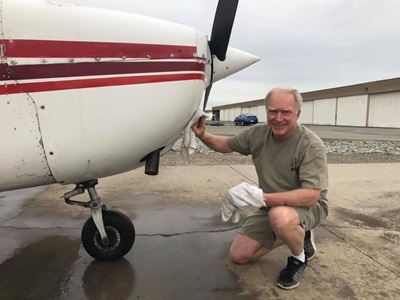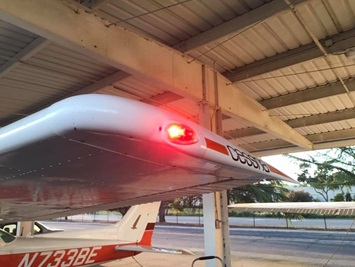Everyone knows the old cliché, “It’s hard to find good help these days.” That’s particularly true when it comes to maintenance. One way flying clubs can operate a well-maintained fleet is to develop members with an interest and aptitude for mechanical projects.
The Flying Particles Flying Club operate eight aircraft from the Livermore Municipal Airport (LVK) in California. In the past two years, since the start of Covid, flight operations have literally taken off with each aircraft averaging between 25 to 35 hours of flight time a month.
With all that flying, having club members volunteer their time to help maintain the aircraft is increasingly important. “We manage eight airplanes and I have a full-time job,” Vice President of Maintenance Elliott Hutton said. “You can’t manage a volunteer organization with just one or two people. It takes a village.”
Identifying Potential Maintenance Officers
The club has plane captains that help manage the maintenance for each aircraft. Under FAR Part 43, Maintenance, Preventive Maintenance, Rebuilding, and Alteration, a certificated pilot may perform certain preventive maintenance on any aircraft owned or operated by that pilot. “That’s basically your general maintenance,” Elliott said. “Everything from oil changes to spark plug cleaning to changing tires.”
To identify potential plane captains or members who can assist with maintenance, the club looks for pilots with strong mechanical backgrounds or a strong aptitude for hands-on work. Someone who has been around airplanes for a number of years or possibly someone with automotive maintenance experience. Sometimes, they are previous aircraft owners.
“What we try to do is recruit plane captains out of the new membership,” Elliott said. “When they first join the club, I look for an interest—are they showing up at the field on a regular basis to fly and stick around to hang out with the maintenance group. That’s a clear sign there is some interest there and some potential opportunity for them.”
Another way the club identifies members to help with maintenance is based on how someone approaches washing an airplane. Someone who can recognize that something is broken, knows what to look for or has more attention to detail often make good candidates for the maintenance team.
“Seeing how they wash an airplane we found people that are interested in doing more,” Elliott said. “It is an activity that we use quite a bit.
Learning the Basics
The club recently recruited a new plane captain. She is working on becoming a CFI and enjoys flying one of the airplanes a lot. That led to a discussion to see if she was willing to help coordinate activities.
“That alone is an opportunity to groom somebody to be a part of the maintenance crew,” Elliott said. “If they are willing to come out on weekends or evenings to keep the airplane clean, to check the airplane for supplies and schedule maintenance activities, which takes the burden off of the maintenance crew.”
From there, the club will pair someone who has shown an interest and willingness to learn with a more experienced plane captain or mechanic. They’ll teach them the routine the club goes through for the oil changes, which is the basic entry point into a club maintenance program.
Once they get comfortable changing oil, they will graduate to learning how to remove and clean plugs, and how to torque properly. Club members who have the skills rise to the top, while those that may struggle or prefer to watch can help out in other ways.
“I’m happy to have the people hanging around as long as they find some activities that they enjoy doing—whether it’s keeping the rags and cleaning supplies stocked in the hangars or even sweeping the hangers out,” Elliott said.
One club member who is working on getting his A&P has been working as an apprentice of sorts with another member who is an IA. “He’s very skilled and very diligent at learning the ropes,” Elliott said. “You look for those kinds of people who are willing to volunteer their time.”
Preparing for annual inspections is another good opportunity to find members who are interested in maintenance and can be developed into a maintenance officer. Many of the tasks are fairly simple, like removing inspection panels or seats. “You begin to teach them how to take care of the plane when you’re doing this kind of maintenance on them,” Elliott said
Once members have shown some initiative, either by checking the club’s dispatch system to see when aircraft are down for maintenance or asking what they can do to help, Elliott will reach out and invite them to participate in more major maintenance work, like removing an engine.
Opportunities for teaching
During the club’s monthly meetings, Elliott, as the Vice President of Maintenance, will give a status update on each aircraft. “I have a standard routine and we go through each aircraft, what’s gotten fixed and then I point out maintenance issues that have turned up over the past month,” he said. “I call them stupid user tricks.”
He details things that have come up on annuals or oil changes, as well as instances where a squawk should have been reported or times where issues should have been caught during a pre-flight inspection but were missed. It’s an opportunity to teach the broader membership about basic maintenance items and that to look out for.
The club will also do some hands-on training during a plane wash or oil change. “We tend to get more of the non-maintenance crew out there scrubbing on airplanes,” Elliott said. “We will show them simple things like what to look for under the cowling, or how to change a bulb. That’s kind of a simple one.”
During an oil change, the club may take the time to teach members what to look for in bad spark plug. “We have a plug cleaner and tester, which measures the resistance, and we look at the test arcs,” Elliott said. “You can tell pretty quickly if the plugs are worn out.”
By identifying members who have an interest and aptitude for maintenance, the club is developing future maintenance officers. In addition, having capable members who can do general maintenance has saved the club a lot of money over the years. “We have an upgrade fund, and we’re flush with engine reserves across these eight airplanes,” Elliott said. “Financially, it’s been a big advantage to the club.”
Factsheet
|
Name |
Flying Particles |
|
Location |
Livermore Municipal Airport (LVK) Livermore, CA |
|
Website |
|
|
|
|
|
Year formed |
1957 |
|
Aircraft |
1981 Cessna 152 ($70/hr + $8 half day) 1977 Cessna 172N ($105/hr + $11.75 half day) 1974 Cessna 182P ($140/hr + $16.50 half day) 1978 Cessna 182Q ($140/hr + $16.50 half day) 1979 Piper Warrior II ($105/hr + $12.50 half day) 1976 Piper Archer II ($110/hr + $12.50 half day) 1977 Piper Archer II ($110/hr + $12.50 half day) 1985 Mooney M20J ($155/hr + $18.50 half day) Rates are Tach time, wet |
|
Joining fee |
$2,500 |
|
Monthly dues |
$80 per month |
|
Membership |
About 200 |
|
Scheduler |